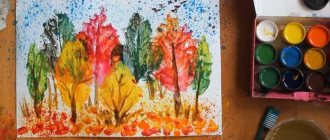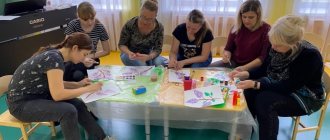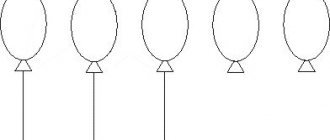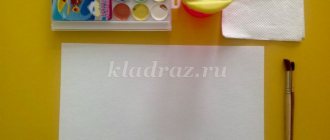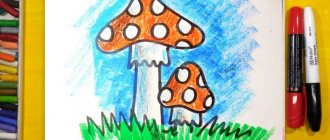Specifics of drawing animals in the second junior group of preschool educational institutions
The organized introduction of children to artistic creativity begins with the second youngest group, since some children begin attending kindergarten from the nursery group, while others come there only at three years old.
The tasks of teaching children in this group are not too ambitious: the main goal is to interest the children in the drawing process itself. They are delighted to discover that the pencil leaves a mark on the paper. Gradually, the teacher teaches preschoolers to notice the similarities between strokes, lines and surrounding objects.
Under the guidance of a teacher, over time, children develop a need not just to draw lines with a pencil and brush, but to depict something. At first these are primitive dots and strokes, then zigzags, outlines and, finally, the simplest forms appear.
The teacher constantly draws the children's attention to the beauty of surrounding objects and objects - the sky with clouds, colorful leaves falling to the ground, beautiful snowflakes sparkling on a mitten. A special object of observation are animals that children can see while walking; many have pets. The group's educational environment necessarily includes pictures and posters with their images. All this will be an additional incentive for drawing.
Three-year-old children consolidate their knowledge of basic colors and become familiar with some shades (gray, pink, blue). When drawing, the teacher constantly focuses on the correspondence of the selected paint to the real color of the object or object.
The children learn not just to draw lines, but to cross them - this creates various objects (a fence, a path, a checkered scarf, etc.). In addition, at this age children master rotational movement - this way you can draw multi-colored balls for a cat.
The teacher leads the children to draw objects of different shapes. For example, this is a primitive bunny, the head, body, legs and tail of which can be depicted in the form of circles of different sizes, and the ears in the form of ovals (the teacher explains to the kids that an oval is an elongated circle).
Scheme for the younger group
Note that in the younger group, children are not yet able to depict an animal realistically. Often the drawings of young artists contain little meaning. The teacher’s task at this stage is to teach children to name objects and objects, to establish a connection between the drawing process and its result.
The depiction of animals at this age is, as a rule, coloring templates and silhouettes that the teacher offers. This is done using various traditional and non-traditional (poke, finger) techniques. Another type of work is finishing the drawing of an object (for example, the tail of a cat or dog, the spines of a hedgehog, the stripes of a zebra, etc.).
In the learning process, the teacher uses methods such as step-by-step explanation with a mandatory demonstration of drawing on the board. The model in this age group is of paramount importance - kids will not be able to depict this or that object without it. Note that the teacher’s drawing, even intended for the smallest children, must be at a decent aesthetic level, not simplified to a diagram. The image must correspond to a real object or object.
Individual work with children is also important. The teacher takes into account the level of mental development of the children (after all, some of them, especially boys, at this age do not yet have coherent speech) and builds work in accordance with this. During the children’s independent productive activities, the teacher constantly approaches the children and guides them.
It should be noted that drawing animals is a rather complex process, although undoubtedly very interesting. And using only traditional techniques in work will not allow children to fully reveal their artistic abilities, imagination and fantasy. Therefore, it seems appropriate to include elements of non-traditional drawing in classes with animalistic themes. For example, the shaggy fur of a kitten can be best conveyed using a poke with a semi-dry brush, and the white coat of a bunny can be beautifully drawn with a finger.
Materials used and base
In drawing classes, the foundation is of great importance, which the teacher must take care of in advance. As a rule, these are ordinary sheets of A4 paper. When painting with paints, the base must be tinted by the teacher in pastel colors. If children have to work with a finished outline, then it should also be shaded.
Sometimes the task of preschoolers in a lesson is not to color the outline, but to complement the painted drawing with details. For example, the teacher draws a green Christmas tree with a squirrel on the base, and the children’s task is to draw cones on the tree. Another option is a drawn and painted hedgehog, on the back of which the children depict red and yellow apples.
Another option is to paint or add details to the template in the form of some kind of animal. In this case, the teacher makes blanks in advance (they can also be tinted if the children have to work with paints).
As for the variety of paints, the younger group usually uses gouache rather than watercolor. In this case, the drawing turns out brighter. Children don't have to put in a lot of effort to get rich color - just dip a brush moistened with water into a jar of paint.
You can also offer children pencils for drawing on animal themes. This is true if children themselves draw the silhouette of an animal. You shouldn’t overuse felt-tip pens at this age, because compared to pencils, they do not provide adequate development of fine motor skills.
Drawing techniques and techniques to use when drawing animals
The key goal of the teacher during visual arts classes in the younger group is to teach children how to properly use the basic tools - a brush and a pencil. Children must learn that they should not be held with the whole fist, but only with their fingers, and not too close to the base and not too far away. It should be noted that often one demonstration is not enough: many preschoolers cannot reproduce the desired position of a brush or pencil. In this case, the technique of placing the instrument in the hand and positioning the fingers in the desired manner is very effective. The child should feel the object in his hand.
In addition, the teacher makes sure that the child does not strain his muscles too much and does not squeeze his fingers - the child’s hand should move freely during the drawing process.
Another important aspect is that children should learn to put paint on a brush: to do this, you need to carefully dip it with all the bristles into the jar, and remove excess paint on its edge. Children should learn that before adding paint of a different color, they should thoroughly rinse the tool and dry it with a napkin or soft cloth.
Additional types of visual activities used, the relevance of an individual approach
In order to further interest pupils of the younger group in the process of drawing animals, the teacher can include additional types of visual activities in the lesson. For example, the eyes of an animal can be sculpted from plasticine - the child presses small balls onto the drawn face of a kitten, hedgehog or bunny. In the same way you can create a funny voluminous nose.
As for the applicative details, the teacher prepares them in advance. For example, kids are offered a green Christmas tree, but they must draw pine cones and stick a squirrel on it. Another option is to draw thorns on the back of the hedgehog and stick paper apples on it. Such diverse work will undoubtedly arouse children's interest.
In this way, tasks can be individualized in terms of complexity in accordance with the level of development of children. For kids who cope well and quickly with the main task, you can offer additional work - to depict the sun (or sculpt it from plasticine). You can draw a rug on a painted kitten.
On the topic: methodological developments, presentations and notes
Summary of an integrated lesson on visual arts (non-traditional drawing techniques) and music on the topic: “Cockerel”.
Summary of educational activities on visual activities (drawing) for children of the younger group “Rain, more often, drip-drip-drip!” using an unconventional technique of drawing with cotton swabs.
A bear comes to visit the children and the children introduce him to their city, Zavodoukovsk.
Animals are always very interesting for children. They love to draw them, but it is still difficult for small children to draw animals and the technique of painting with a dry brush “Poke” comes to their aid.
Program content: Teach children to draw in an unconventional way - with a cotton swab; Expand children's understanding of plants and animals in the spring; Develop children's skills in applying stains unconventionally.
Form friendly relations in the team, contribute to the accumulation of experience of friendly relations, a negative attitude towards rudeness. Develop children's spoken language and enrich their vocabulary.
Source
Specific options for compositions (including collective ones) within the theme
It is advisable to offer drawing of animals and objects related to this topic to children of the younger group after studying the relevant topics in classes to familiarize themselves with the world around them. In addition, such work can be related to the development of speech - done after reading fairy tales, poems, nursery rhymes on a given topic. For example, after learning the fairy tale “The Three Bears” or “Masha and the Bear,” children can draw a Clubfoot Bear or a bears’ hut.
Reading the nursery rhyme “A squirrel is sitting on a cart...” to children will be an occasion to draw this red, fluffy beauty (composition “Squirrel”, “Nuts for a Squirrel”, Pine Cones for a Squirrel”). And after the teacher reads the nursery rhyme Little Kitten, the children will enthusiastically draw a cat (like the variation “Kitten”, “Balls for Kittens”).
We also offer the following options for work on an animalistic theme: “Hedgehog”, “Needles for a hedgehog”, “Dressing up a hedgehog” (kids depict needles in the silhouette), “Apples for a hedgehog” (apples are added to the back of a painted hedgehog), “Bunny”, “ Carrot for a bunny" (the missing details are added to the hare's silhouette, for example, ears, a tail and a carrot is "put" in its paws), "Zebra" (stripes are drawn on the entire body).
As for group work, in the younger group it is offered to children relatively rarely. As an option, the teacher draws on the base of a large hedgehog, and the kids take turns drawing apples on its back, choosing their color themselves (red, yellow or green).
Drawing in the second junior group of domestic and wild animals: lesson notes
| Author's full name | Title of the abstract |
| Zinchenko I. | "Fluffy kitten" (painting with a poke) Educational objectives: introduce the technique of poking using a dry brush, teach how to convey the distinctive features of a kitten. Developmental tasks: develop creativity, perseverance, accuracy when working with gouache paints. Educational tasks: to cultivate interest and respect for animals, the ability to notice the beauty of the surrounding world, the desire to help others. Integration of educational areas: “Artistic creativity”, “Cognition”, “Communication”, “Socialization”, “Health”. Demo material: toy cat. Handout: sheets of white paper with an outline image of a kitten according to the number of children, gouache (black, brown, gray and orange), sippy cups, brushes with stiff bristles, coasters for them. Progress of the lesson: A toy cat comes to the group of children. Children look at her, admire her white fluffy fur, and stroke her. The teacher invites the children to turn into little kittens themselves and conducts physical education with them:
The kittens “turn” into children again. The cat turns to them with a request: to draw shaggy fur for her kittens so that they do not feel cold in winter. The teacher informs the kids that they will paint with a hard brush and invites them to pick it up and touch it. The brush should be held vertically, closer to the “skirt”. Children are given the right to choose the color of their kitten - gray, red or black. The teacher demonstrates on the board the process of drawing fur on a finished silhouette of a kitten. Independent activity of children. Exhibition of works. The kitty is very happy (now the kittens won’t freeze in winter) and says “thank you” to the guys. |
| Ivanova E. | “And a zebra has stripes everywhere.” (painting with gouache) Doctor Aibolit comes to the guys and invites them to hot countries. Children guess riddles about African animals:
Then the guys close their eyes, sit on a magic carpet (an ordinary carpet) and “fly” to Africa. Pictures of animals are hung on the board. Physical education “Zebra striped” is being held
Doctor Aibolit points out that the zebra in the picture has no stripes - they were washed away by the magic rain. And only the guys can help the zebra - draw new black stripes for it. The teacher demonstrates techniques for depicting stripes. Independent activity of children. Exit from the fairy tale: preschoolers with Aibolit again sit on the magic carpet and fly into the group. Aibolit says goodbye to them. |
| Marchenko O.I. | "Let's dress up the hedgehog" (drawing with a felt-tip pen) A hedgehog from the forest comes to visit the kids. The teacher talks with the children, asks which of the children saw a live hedgehog and why it needs thorns. Physical education “Hedgehog and Drum” is being held
The teacher invites the children to “dress up the hedgehog” - draw needles on its back using a felt-tip pen. Demonstrates the imaging process. Children draw on their own and then look at each other's drawings. |
| Alekseeva F.Sh. | "Eared Hare" The teacher invites the kids to go skiing into the winter forest. Children imitate the process of putting on skis and go. In the snow (paper that lies on the floor) they notice someone's footprints. With the help of the teacher, the children determine that they belong to a fox, a bunny, a wolf and birds. Children guess the riddle about the hare. A sad bunny appears and whispers in the teacher’s ear that he is bored playing alone. The teacher and children offer to draw him many friends. They discuss what color this animal’s fur coat is in winter and what parts of its body it has. The teacher shows the children the process of drawing a hare with white paint using a hard brush. The image begins with the largest part - the body, then the head, ears, tail, and paws are drawn. Children realize that they are missing eyes, a nose and a mustache - they need to be painted with a regular brush. Physical education “Hares” is being held
Children draw on their own. The bunny is very happy that he has found new friends and says goodbye to the kids. The way out of the fairy-tale situation is for the children to “put on” their skis again and return from the forest to the group. |
Scheme for drawing up lesson notes
The lesson for children lasts 15 minutes. This time is distributed between three stages of mastering the topic:
- introductory stage - up to 3 minutes, aimed at motivating the children;
- the main stage - up to 10 minutes, devoted to a description of the work procedure, demonstration of drawing samples and the drawing process itself, which is preceded by finger exercises and/or physical education;
- the final stage - up to 2 minutes, during which the teacher praises and thanks all the kids for their work.
Table: Cheryapkina L. Summary of a drawing lesson on the topic “Balloons” in the second junior group (fragments)
| Stage | The essence |
| Introductory | The teacher tells the children that he has a gift for them and asks them to guess the riddle: I’m in a hurry for the holiday, I’m holding them by a thread: Red, yellow, blue - They float overhead, There’s nothing better for the kids than the airy ones. — Balloons (helps if children find it difficult to answer, shows a ball)…> |
| <… The teacher invites the children to play with the ball. Physical exercise: Children stand in a circle and hold hands. The adult slowly, melodiously pronounces the words, stepping back: “Inflate my balloon!” “Blow up big...” Everyone stops, holding hands and forming a large circle. The teacher continues: “Stay like that and don’t burst... bang!” - Let's inflate again! - Repeats the words of the game. The ball loves to be thrown up and caught, the ball wants to lie down, the ball can jump (children perform a variety of movements). | |
| Basic | Educator: - Do you like playing with the ball? Let's draw a lot of balls. — Kids love paints and pencils. We will use them to draw What? Can you guess? (ball) - Guys, today we will draw colored balls. You have multi-colored strings drawn on your leaves. Let’s “tie” a red ball to the red thread, a blue ball to the blue thread, a yellow ball to the yellow thread, and a green ball to the green thread. |
| Finger gymnastics | |
| The teacher shows the children how to hold the brush correctly: with three fingers, just above the iron tip, making sure that the children sit straight. First, children perform circular movements in the air, then carefully dip the brush first into water, then into paint. Excess paint is squeezed out on the edge of the jar. The brush is washed from paint and wiped with a napkin. | |
| Final | The teacher puts all the children's drawings on display, analyzes the children's work, praises the children, and, if necessary, helps a child who has difficulty completing a task. |
| Quote from: https://www.maam.ru/detskijsad/konspekt-zanjatija-po-risovaniyu-vo-vtoroi-mladshei-grupe-konspekt-nod-vozdushnye-shary-dlja-detei-2-ml-gr.html | |
Video: drawing lesson on the theme “Chicken” in the second junior group
Drawing on animalistic themes with younger preschoolers opens up new facets of their ideas about the world around them, expands the experience of perceiving the shapes, sizes of objects, as well as shades of colors. Practicing this type of art activity also helps to reveal the creative abilities of little pupils, teaches them to work with different materials for drawing, which is an important stage in the formation of experimental research activities. It also fosters a respectful and caring attitude towards animals and nature in general.
Examples of completed works by kindergarten students with comments
The use of various techniques (traditional and non-traditional) develops children's creative imagination and fine motor skills. The works are varied and original. Thus, painting with a poke with a hard brush ideally conveys the shaggy skin of a bear (drawing “Teddy Bear”), the snow-white coat of a bunny shimmering against a winter background (“Little White Hare” and the fluffy fur of a cat (“Red Cat”).
The work “Mishutka” was performed at a high level - the pupils of the junior group depicted the figure of a bear independently using only a simple pencil. Fine shading along the contour conveys the structure of the bear's skin. The animal's face is drawn quite realistically.
When performing the composition “Kitten”, the children independently chose the color of the animal. Against the background of numerous red pets, a black kitten looks very impressive.
Pine cones are carefully drawn in the drawings “Pine cones for a squirrel” (the kids completed the image of a Christmas tree and a squirrel.
In the work “And the Zebra Has Stripes Everywhere,” the child not only painted the animal’s skin, but also used green strokes to depict the grass on which it stands.
A hedgehog painted with fingers looks interesting - using this technique creates an interesting volumetric effect.
On the topic: methodological developments, presentations and notes
Goal: to form an idea of the family and its members, of the friendly, friendly relationships of relatives. Objectives: Educational: - naming family members, active use of generalizing words.
Goal: to teach how to depict round objects with one movement of the hand.
Summary of continuous educational activities in drawing in the second junior group “Boat”.
Summary of continuous educational activities in drawing in the second junior group, adapted for carrying out under quarantine conditions. “Apples for bunnies” Prepared by Kireychikova M.Yu.Ts.
Summary of continuous educational activities in drawing in the second junior group, adapted for carrying out under quarantine conditions. “Apples for bunnies.”
Development of productive visual activity: the ability to draw with cotton swabs, using gouache.
Source
